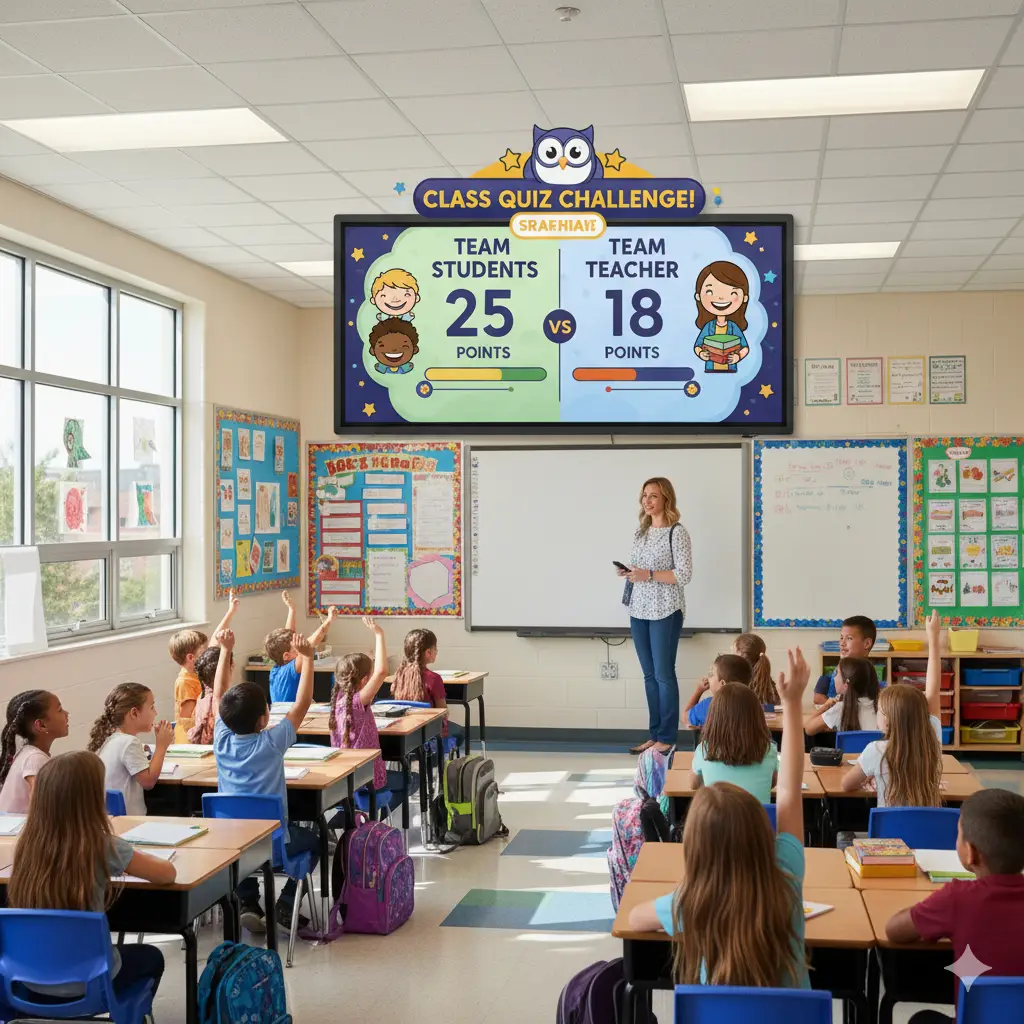Introduction: Why Games Work in Classroom Management
The management of a classroom goes beyond than simply keeping kids quiet, it’s creating an atmosphere that encourages learning. Conventional strategies such as the rules and consequences are essential and are often harsh and uninteresting for the students. That’s where game-based classroom management comes in. The games transform discipline into a constructive, cooperative event that promotes the participation of students, rewards positive behaviors, and helps to build the sense of community. The research shows that games increase the motivation of students and helps reduce destructive behaviors (Edutopia 2023). In my time as a middle school teacher, I discovered that using small, regular games helped keep students engaged with no constant reminders or discipline reminders. In this piece we’ll discuss strategies for managing classrooms that are effective, examples from real life of their success, as well as practical strategies to make them a part of your routine.
The Psychology Behind Gamified Classroom Management
How come games of classroom management perform so well? The answer lies in human psychology. The brain is flooded by games. reward system by releasing dopamine whenever goals are met. For kids, even minor victories, like earning points for groupwork — feel significant. They also increase intrinsic motivation, by providing students with specific goals and instant feedback. According to the educational psychologist Alfie Kohn “rewards can reinforce desired behaviors when tied to community goals rather than individual compliance.” In my class, moving away to “stop talking” reminders to teams-based games significantly reduced interruptions. Instead of penalizing misbehavior games encourage collaboration and concentration. This allows children to be more self-controlled while increasing the accountability of peers.
Benefits of Classroom Management Games
Before we get into the specifics of games, let’s review some of the benefits that are most important:
-
Focused better students stay active by engaging challenges.
-
Reducing conflicts games encourage collaboration and decrease power struggle.
-
Rewarding positive behavior The good behavior of a person is celebrated publicly, which boosts morale.
-
Participation for all Each student gets the opportunity to participate and contribute, including those who are quiet.
-
Culture of the classroom The fun and collaborative environment replaces stress.
One example is that a fifth grade teacher from Chicago saw the drop of 30% in referrals for behavior after she implemented daily games of 10-minute duration. The simple change saved her instructional time as well as helped the students transition smoothly between classes.
Game 1: The Quiet Game (Classic but Effective)

It’s called the Quiet Game is one of the most popular and most effective techniques for managing classrooms. The way it works is it requires students to be still, while the instructor is able to award privileges or points to those who remain focused. It can be made challenging by breaking students into groups, or making it the form of a time-based challenge.
A Case Example In my class in the second grade I played my Quiet Game during hallway transitions. Instead of constantly reminding students to “Stop talking!” students were encouraged to score points to their table groups. In just two weeks, raucous corridor trips were transformed into quiet and orderly shifts. What makes this game so appealing is the simplicity of it–you don’t need any equipment, and it is effective for all ages.
Game 2: Beat the Teacher
For Beat the teacher the students battle each other. Every time they comply with the instructions fast, they get points. If they’re distracted and the instructor is penalized, they earn one point. After the day, the student with the highest points will win.
What it does: Students love flipping the script and then suddenly, it is the teacher who is getting pushed! The fun-filled competition encourages kids to keep their focus.
Actual Experience: A high school science teacher who I know has used Beat the Teacher as a way to handle the lab’s cleaning. Instead of spending the time nagging students, cleaning only took 5 minutes as students were eager for them to “win.”
Game 3: Mystery Student
In the mystery game You choose one person at the start of the class. If that student is able to follow the rules throughout the class The class is awarded an award for the entire class. In the event that they don’t, nobody can identify the student which is why the accountability of everyone else is shared with no embarrassment.
case study: An elementary school teacher from Texas said the Mystery Student drastically reduced disruptions. Students did not would like to risk losing an incentive for their group, therefore they encouraged their peers to remain in the right direction. This activity builds accountability among peers and decreases conflict between students and teachers.
Game 4: Classroom Bingo
Classroom Bingo is a game that combines tracking behavior and the excitement of a game. Make a bingo card with positive actions (e.g., “raise your hand,” “complete homework,” “transition quietly”). Every time a class displays any behavior, you write the behavior off. If they win or a prize, they will be rewarded.
A Note from a Personal Perspective: I used this game to help with homework. Instead of complaining about missed assignments, students clapped when they got a point in the 100% mark. The class reframed the notion of responsibility to an opportunity for party.
Game 5: Line-Up Challenge
Changes can cause chaos However, The line-up challenge transforms them into an enjoyable game. Record the time students take to stand in a quiet line. Every day, they attempt to break their record.
The reason teachers love it: This game fosters collaboration and improves effectiveness. Students who are younger especially enjoy watching the stopwatch countdown.
A Case Study: One third-grade teacher from California cut down on transition time by 40 percent after the daily task of lining up. This saved 20 minutes of instruction each week.
Read More: Wheon Gaming: The Future of Virtual Experiences
How to Implement Classroom Management Games Effectively
It’s easy to add games and successful, however it is dependent on fairness and consistency. Here are a few suggestions:
-
Beginning with small Start by introducing only one game at a given time in order to avoid confusion.
-
Create clearly defined expectations The students should be aware of the behaviors that earn them points.
-
Keep it up Make use of games regularly and not only occasionally.
-
Find a balance between fun and structure Make sure that games are fun However, don’t allow them to distract you.
-
Games that are rotated Stop boredom from occurring with a change in format every couple of weeks.
If played properly If they’re done correctly, games aren’t a waste of time. In fact even save it by cutting down on the amount of disruptions.
Reviews & Teacher Feedback
Teachers report consistently positive results of classroom management exercises:
-
“Beat the Teacher. It saved my mental health when I was in changes. Sixth graders begging to have fun!” – Mr. Jameson Middle School Teacher
-
“Mystery Student is one of my favorite books. The suspense is what keeps the audience interested.” -Ms. Rivera, 4th Grade teacher
-
“Classroom Bingo made homework completion fun instead of a chore.” – – Ms. Li, 5th Grade teacher
The most trusted education platforms such as Edutopia or Teachers Channel are also highlighting gaming as an effective approach to engage students.
Conclusion: Turning Discipline Into Play
Classroom management shouldn’t be a continuous battle. Through the integration of games such as Quiet Game, Beat the Teacher as well as Mystery Student, teachers can move away from disciplining their students to recognizing collaboration. The games can boost an intrinsic sense of motivation, teamwork and respect, without draining teachers’ enthusiasm. It’s all about the consistency and the creativity. Beginning small, you can test the strategies that work with your students and change activities regularly to keep the learning interesting and fresh. No matter if you teach in high school or kindergarten These strategies will transform your classroom into one that is a place where learning is enjoyable and discipline is easy.
Have you ever tried one of these in your class? Let us know your thoughts in the comments section below. Don’t be forgetting to share this article onto a colleague that could benefit from a bit of magical classroom.
Read More: Foullrop85j.08.47h Gaming: A New Wave in the Gaming World
For more engaging content and the latest updates, follow The Bunk knot for insightful articles and fresh perspectives!
Also follow: mastodon.social/@bunkknot


